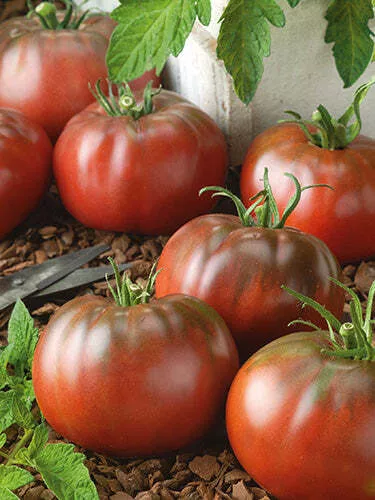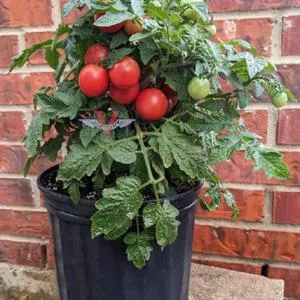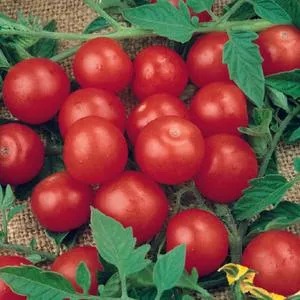Black From Tula Tomato
Solanum lycopersicum
Price: $4.45
SKU: 340365185 days, indeterminate - The plants of 'Black from Tula' tomatoes have heavy, dense, regular leaf foliage that protect its fruit from sun scald, but at the same time, can potentially contribute to disease issues. Be sure to give them a lot of space and keep them staked up to promote better air circulation and you will be rewarded with amazingly flavorful fruit.
Its fruit are brownish-red in color, flattened-globe shaped, weighing up to twenty ounces, and deliver flavors that have been described as sweet and rich to salty and smokey, depending on the climate and growing conditions in the particular location. Excellent for slicing for fresh eating, as well as for canning.
According to Dr. Carolyn Male on pages 62 and 63 of her book, "100 Heirloom Tomatoes for the American Garden," 'Black From Tula' originated in the Ukraine.[1] We still do not know the full story about why an heirloom tomato from the Ukraine is named after an industrial town in Russia. What we do know that it was first introduced to American seed savers in 1996 by Marina Danilenko, a pioneering private seed seller from Moscow (see below) during the Perestroika-era.[2] 'Black From Tula' is in the SSE collection a SSE Tomato 2911.
Marina Danilenko and her mother – who was a tomato collector – started the first private seed company in Moscow and a similar company in their home city in the Urals in 1990. Prior to this, all vegetable seeds in the former Soviet Union had been produced by a network of collective farms and sold in seven government operated seed stores in Moscow, as well as in similar stores in cities throughout the former Soviet Union.
Marina and her mother began by buying seeds from this network and then paying retirees to fill her seed packets. She began advertising her company in newspapers and magazines, gardeners would send her their names and addresses, then a price list was sent for people to use to place orders. The business exploded! Within the first couple of years, they were mailing price lists to about 80,000 Russian gardeners and selling about 500,000 seed packets via mail-order. In this recently post-Soviet society, the postal service was corrupt, she incurred considerable loss, but she pushed on.
In 1992, Marina reached out to the Moscow branch of the famous Vavilov Institute to grow out some of her vegetable seed stock. She described that, "... the staff is highly professional, their seeds are finest quality, and the Institute certainly needs the money."
It was at about this time that the Seed Savers Exchange sponsored her to come to the United States for visits two years in a row. Here she was able to learn how American mail order seed companies operated, which was critically important considering that the Russian people at that time had no context or informational resources on how to successfully operate a business in a post-communist economy.
By 1993, Marina had supplied at least 170 different Russian tomato varieties into the Seed Savers Exchange's collection. Included in these were some of the first black fruited tomatoes such as 'Paul Robeson' and 'Black from Tula', as well as other popular varieties such as 'Orange Banana' and 'Silvery Fir Tree'.[3]
Marina and her mother began by buying seeds from this network and then paying retirees to fill her seed packets. She began advertising her company in newspapers and magazines, gardeners would send her their names and addresses, then a price list was sent for people to use to place orders. The business exploded! Within the first couple of years, they were mailing price lists to about 80,000 Russian gardeners and selling about 500,000 seed packets via mail-order. In this recently post-Soviet society, the postal service was corrupt, she incurred considerable loss, but she pushed on.
In 1992, Marina reached out to the Moscow branch of the famous Vavilov Institute to grow out some of her vegetable seed stock. She described that, "... the staff is highly professional, their seeds are finest quality, and the Institute certainly needs the money."
It was at about this time that the Seed Savers Exchange sponsored her to come to the United States for visits two years in a row. Here she was able to learn how American mail order seed companies operated, which was critically important considering that the Russian people at that time had no context or informational resources on how to successfully operate a business in a post-communist economy.
By 1993, Marina had supplied at least 170 different Russian tomato varieties into the Seed Savers Exchange's collection. Included in these were some of the first black fruited tomatoes such as 'Paul Robeson' and 'Black from Tula', as well as other popular varieties such as 'Orange Banana' and 'Silvery Fir Tree'.[3]
Fruit Color: Brown
Fruit Color: Black
Special Groups: "Epic" Tomatoes
Harvest Timing: Late Season
Genetic Classification: Open Pollinated
Fruit Color: Black
Special Groups: "Epic" Tomatoes
Harvest Timing: Late Season
Genetic Classification: Open Pollinated
Sow seeds indoors (do not direct sow into the garden), using sterile seed starting mix, 6 to 8 weeks before your last expected frost date. Plant 1/4" deep, water lightly but keep moist until emergence.
Full light and cooler temps (60° to 70°) will help to prevent the seedlings from becoming too leggy. If plants become rootbound before you can safely set them into the ground, transplant them into larger pots.
Harden off plants before planting outside. Young plants are very susceptible to frost and sunburn damage. Avoid too much nitrogen. Water evenly but not in excess.
Click here to view our full tomato growing guide.
Full light and cooler temps (60° to 70°) will help to prevent the seedlings from becoming too leggy. If plants become rootbound before you can safely set them into the ground, transplant them into larger pots.
Harden off plants before planting outside. Young plants are very susceptible to frost and sunburn damage. Avoid too much nitrogen. Water evenly but not in excess.
Click here to view our full tomato growing guide.
Informational References:
- "100 Heirloom Tomatoes for the American Garden," Dr. Carolyn Male, Workman Publishing, 1999, pages 62-63.
- "Seed Savers Exchange Yearbook," Seed Savers Exchange, Decorah, Iowa, 1996.
- "Rescuing Traditional Food Crops in Eastern Europe and the Former Soviet Union," Transcript of a speech given by Kent Whealy at 1993 Seed Savers Exchange's annual Campout.
Customer Reviews:
Do you have experience with this one? 📝 📣 Write a review!
★★★★★ Black from Tula
By Karen Chastain (Visalia ca) on July 17, 2025
By Karen Chastain (Visalia ca) on July 17, 2025
Love the flavor on these. One of the first to ripen in my garden. Not very prolific.





